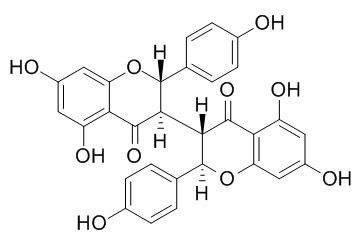Isochamaejasmine
Isochamaejasmine has inhibition of NF-kappaB activation, which could reverse the anti-apoptotic effect; it induces apoptosis in leukemia cells by inhibiting the activity of Bcl-2 family proteins, providing evidence for further studying the underlying anti-cancer mechanism of S. chamaejasme L. Isochamaejasmine shows antiplasmodial activity, with an IC(50) of 7.3+/-3.8 microM, but the selectivity was rather limited.
Inquire / Order:
manager@chemfaces.com
Technical Inquiries:
service@chemfaces.com
Tel:
+86-27-84237783
Fax:
+86-27-84254680
Address:
1 Building, No. 83, CheCheng Rd., Wuhan Economic and Technological Development Zone, Wuhan, Hubei 430056, PRC
Providing storage is as stated on the product vial and the vial is kept tightly sealed, the product can be stored for up to
24 months(2-8C).
Wherever possible, you should prepare and use solutions on the same day. However, if you need to make up stock solutions in advance, we recommend that you store the solution as aliquots in tightly sealed vials at -20C. Generally, these will be useable for up to two weeks. Before use, and prior to opening the vial we recommend that you allow your product to equilibrate to room temperature for at least 1 hour.
Need more advice on solubility, usage and handling? Please email to: service@chemfaces.com
The packaging of the product may have turned upside down during transportation, resulting in the natural compounds adhering to the neck or cap of the vial. take the vial out of its packaging and gently shake to let the compounds fall to the bottom of the vial. for liquid products, centrifuge at 200-500 RPM to gather the liquid at the bottom of the vial. try to avoid loss or contamination during handling.
Mol Med Rep.2015, 12(5):7789-95
OENO One2023, 57:3.
Mol Cancer Ther.2024, 1535-7163.
University of Limpopo2016, 1777
Int J Mol Sci.2017, 18(12)
Toxicol Res.2019, 35(4):371-387
Molecules.2023, 28(19):6767.
Biotechnology and Bioprocess Engineering2024, 29:1048-1060.
Antioxidants (Basel).2020, 9(4):284.
Food Research International2023, 113792.
Related and Featured Products
Mol Pharmacol. 2005 Dec;68(6):1534-42.
Stereospecific induction of nuclear factor-kappaB activation by isochamaejasmin.[Pubmed:
16141313]
The root of Stellera chamaejasme L. is a traditional Chinese herb termed Rui Xiang Lang Du and has been used to treat solid tumors, tuberculosis and psoriasis. Exactly how S. chamaejasme L. regulates cellular responses remains unclear.
METHODS AND RESULTS:
We examined four biflavonoids isolated from S. chamaejasme L., including isochamaejasmin(Isochamaejasmine), two of its stereo-isomers and a methyl derivative, in functional assays originally designed to screen ligands for the G protein-coupled formyl peptide receptor-like 1 (FPRL1). Isochamaejasmin(Isochamaejasmine) was found to induce the expression of a nuclear factor (NF)-kappaB-directed reporter gene in transfected HeLa cells with an EC50 of 3.23 microM, independently of FPRL1. The isochamaejasmin-stimulated NF-kappaB reporter activity was accompanied by nuclear translocation of NF-kappaB proteins and was blocked by a dominant-negative construct of IkappaBalpha. Isochamaejasmin(Isochamaejasmine) also induced time-dependent phosphorylation of the mitogen-activated protein kinases extracellular signal-regulated kinase 1/2 and p38, and a novel protein kinase C (PKCdelta). Likewise, inhibition of these kinases with the respective pharmacological inhibitors significantly reduced the isochamaejasmin(Isochamaejasmine)-stimulated NF-kappaB activation. It is noteworthy that the two stereoisomers and the methyl derivative did not induce detectable activation of NF-kappaB and were more cytotoxic than isochamaejasmin, which could partially rescue cycloheximide-induced apoptosis. Inhibition of NF-kappaB activation reversed the anti-apoptotic effect of isochamaejasmin(Isochamaejasmine).
CONCLUSIONS:
These results provide the first evidence for a potential mechanism of action by S. chamaejasme L., and indicate that structurally similar compounds derived from S. chamaejasme L. may have different pharmacological properties.
Phytochemistry. 2010 May;71(7):785-91.
Antiplasmodial activity of (I-3,II-3)-biflavonoids and other constituents from Ormocarpum kirkii.[Pubmed:
20189612 ]
Preliminary screening of a series of medicinal plants, traditionally used in Tanzania, showed an IC(50) of 15.6-31.2 microg/ml for the crude extract of the root of Ormocarpum kirkii S. Moore (Papilionaceae) against Plasmodium falciparum. A bioguided isolation was performed in order to isolate the active constituents.
METHODS AND RESULTS:
Twelve constituents were obtained and identified using NMR and MS data, and optical rotation measurements. The compounds comprised seven (I-3,II-3)-biflavonoids, three (I-3,II-3)-bi-4-phenyldihydrocoumarins, an isoflavanone and a C-glucosylated flavone. Six compounds, liquiritigeninyl-(I-3,II-3)-naringenin, apigeninyl-(I-3,II-3)-naringenin, 7-O-beta-D-glucopyranosylchamaejasmin, (3R,4S,3''R,4''S)-5,5''-di-O-methyldiphysin, 7-O-beta-D-glucopyranosyldiphysin, and 4''-hydroxydiphysolone, were isolated in addition to six known components. The compounds were evaluated for antimicrobial activity in a broad screening panel, including P. falciparum. Seven of these showed antiplasmodial activity; isochamaejasmin(Isochamaejasmine) being the most active with an IC(50) of 7.3+/-3.8 microM, but the selectivity was rather limited.
CONCLUSIONS:
Thus, these constituents may contribute, at least in part, to the antimalarial use of O. kirkii in traditional medicine.
Chinese Journal of Natural Medicines,2015,13(9):660-6.
Isochamaejasmin induces apoptosis in leukemia cells through inhibiting Bcl-2 family proteins.[Pubmed:
26412425]
The biflavonoid isochamaejasmin is mainly distributed in the root of Stellera chamaejasme L. (Thymelaeaceae) that is used in traditional Chinese medicine (TCM) to treat tumors, tuberculosis, and psoriasis.
METHODS AND RESULTS:
Herein, isochamaejasmin(Isochamaejasmine) was found to show similar bioactivity against Bcl-2 family proteins to the reference Bcl-2 ligand (-)-gossypol through 3D similarity search. It selectively bound to Bcl-xl and Mcl-1 with Ki values being 1.93 ± 0.13 μmol·L(-1) and 9.98 ± 0.21 μmol·L(-1), respectively. In addition, isochamaejasmin (Isochamaejasmine) showed slight growth inhibitory activity against HL-60 with IC50 value being 50.40 ± 1.21 μmol·L(-1) and moderate growth inhibitory activity against K562 cells with IC50 value being 24.51 ± 1.62 μmol·L(-1). Furthermore, isochamaejasmin(Isochamaejasmine) induced apoptosis of K562 cells by increasing the intracellular expression levels of proteins of the cleavage of caspase-9, caspase-3, and PARP which involved in the Bcl-2-induced apoptosis pathway.
CONCLUSIONS:
These results indicated that isochamaejasmin(Isochamaejasmine) induces apoptosis in leukemia cells by inhibiting the activity of Bcl-2 family proteins, providing evidence for further studying the underlying anti-cancer mechanism of S. chamaejasme L.



